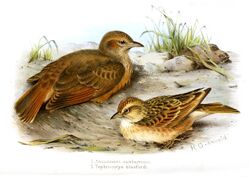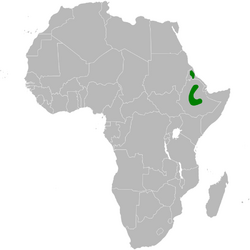Biology:Blanford's lark
| Blanford's lark | |
|---|---|

| |
| C. blanfordi (bottom, right) | |
| Scientific classification | |
| Domain: | Eukaryota |
| Kingdom: | Animalia |
| Phylum: | Chordata |
| Class: | Aves |
| Order: | Passeriformes |
| Family: | Alaudidae |
| Genus: | Calandrella |
| Species: | C. blanfordi
|
| Binomial name | |
| Calandrella blanfordi (Shelley, 1902)
| |
| Subspecies | |
|
See text | |

| |
| Synonyms | |
| |
Blanford's lark[2] or Blanford's short-toed lark (Calandrella blanfordi) is a small passerine bird of the lark family, Alaudidae, which is native to north-eastern Africa. Its common name commemorates the English zoologist William Thomas Blanford.
Taxonomy and systematics
Blanford's lark was formerly included in either the greater short-toed lark (C. brachydactyla) or the red-capped lark (C. cinerea) but is now commonly treated as a separate species. Alternate names for Blanford's lark include Blandford's lark, Blandford's short-toed lark and Blanford's red-capped lark.[3]
Subspecies
Two subspecies are recognized:[4]
- C. b. blanfordi - (Shelley, 1902): Found in northern Eritrea
- C. b. erlangeri - Erlanger's lark- (Neumann, 1906): Found in Ethiopia
Description
Blanford's lark is 14–15 centimetres long. The upperparts are pale sandy-brown with some darker streaking and the crown is rufous. The underparts are pale and plain apart from a small dark patch on the side of the neck made up of vertical streaks. The greater short-toed lark is similar but has a greyer, more-streaked crown. Erlanger's and red-capped larks have darker upperparts with more streaking and a darker rufous crown. Erlanger's lark has larger dark neck-patches while in red-capped lark the patches are rufous.
Blanford's lark has a sparrow-like flight-call. The song is given in a circular song-flight and includes a mixture of chew-chew-chew-chew notes and fluid phrases.
Habitat and movements
They occur on open stony plains, often with bushes. In Arabia, it breeds between 1800 and 2500 metres above sea-level with some birds dispersing to lower ground in winter. The species is often seen in flocks outside the breeding season.
References
- ↑ BirdLife International (2017). "Calandrella blanfordi". IUCN Red List of Threatened Species 2017: e.T103766090A112872569. doi:10.2305/IUCN.UK.2017-1.RLTS.T103766090A112872569.en. https://www.iucnredlist.org/species/103766090/112872569. Retrieved 19 November 2021.
- ↑ ENGLISH NAME UPDATES - IOC Version 2.9 (July 10, 2011) , IOC World Bird List
- ↑ "Calandrella blanfordi - Avibase". http://avibase.bsc-eoc.org/species.jsp?lang=EN&avibaseid=533BEDA4&sec=summary&ssver=1.
- ↑ "IOC World Bird List 6.4". IOC World Bird List Datasets. doi:10.14344/ioc.ml.6.4. http://www.worldbirdnames.org/ioc-lists/crossref.
- Arlott, Norman (2007) Birds of the Palearctic: Passerines, HarperCollins, London.
- Beolens, Bo & Watkins, Michael (2003) Whose Bird?: Men and women commemorated in the common names of birds, Christopher Helm, London.
- Hollom, P. A. D.; Porter, R. F.; Christensen, S. & Willis, Ian (1988) Birds of the Middle East and North Africa, T & AD Poyser, Calton, England.
- Sinclair, Ian & Ryan, Peter (2003) Birds of Africa south of the Sahara, Struik, Cape Town.
Wikidata ☰ Q3232961 entry
 |


